No matter which train you take in this country, the journey is spectacular
By Tim Richards
Riddle me this: when is an express not an express?
I’m pondering this question while gazing at pretty Swiss pastoral scenes with cows in green meadows, framed by mountains. I’m travelling westward from Interlaken aboard the GoldenPass Express, a train which takes about three hours and 15 minutes to travel the 130 kilometres to Montreux – an average speed of 40 kilometres an hour.
To be fair, “express” literally means the train stops at limited stations, not necessarily quickly. And seated as I am in Prestige Class, I have no great desire for the trip to end. This class features seating arranged 2+1, and I’m in a single seat right at the front of the first carriage, in a raised section which provides great views through big windows.
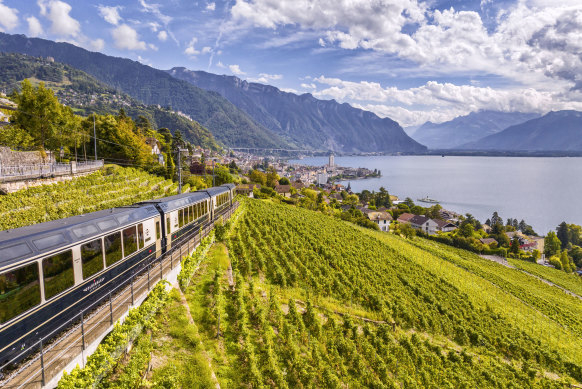
The scenery is always a delight to look at in Switzerland.
The Prestige seat (a notch above first class) is surprisingly snug but comfortable, and the conductor has deftly turned it to face the direction of travel. So I’m soon enjoying views over Lake Thun, a beautiful broad expanse of glacial green water dotted with small boats.
Ah, Switzerland; the scenery is always a delight to look at, and even more so from its extensive railways. And that’s the point of this visit – I’ll be riding some of the nation’s lesser-known routes, part of a selection labelled the Grand Train Tour of Switzerland. I’ll be heading roughly anti-clockwise around the small but lofty country by train, with some opportune side-trips up mountains via diverse means of transport.
GoldenPass Express
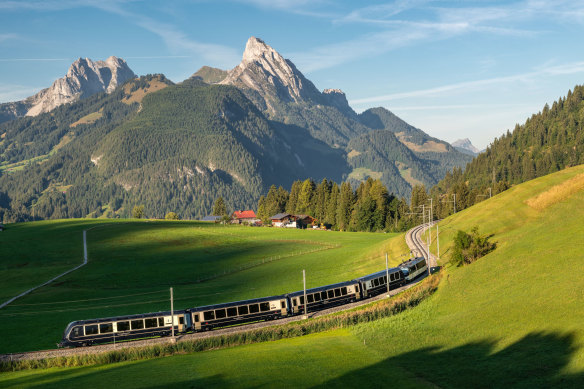
Through Switzerland from Montreux to Interlaken on the GoldenPass Express at not quite an express pace.
My first train, the GoldenPass Express, is a surprisingly new service, having only started operating in December, 2022. Its route from Interlaken to Montreux has two different rail gauges: the section from Interlaken to Zweisimmen runs on standard-gauge track, while the ongoing section to Montreux operates over narrow-gauge rails placed a mere metre apart. Enter clever Swiss engineers who devised a system by which the train automatically changes gauge halfway, retracting its standard-gauge wheels and lowering a narrower set.
This technology will allow us to travel the entire route with minimal disruption, and I’m looking forward to the second section in particular. As a rule, narrow-gauge railways in Switzerland were built to conquer difficult terrain involving steep slopes and tight passes – which means great scenery for those travelling along them. Meanwhile I’m served a pre-ordered aperitif platter which contains a selection of local meats and cheeses, with a drink on the side.
At Zweisimmen the wheel-transforming magic is performed, and the locomotive which has hauled us so far rolls away. A driver hops into the cab at the front of our carriage, so from now on, I have a view forward through his window, as well as along each side. As we pull away, there’s a dramatic change in the landscape, as the narrower line twists and turns through the Simmen Valley, past charming timber buildings and sloping pastures. This vista is reinforced by the curious clanging cowbell sound which alerts passengers to an approaching station stop.
The train gently sways as we trundle through the attractive surrounds, revealing glimpses of Lake Geneva as we make our way down to Montreux. It’s been a delightful journey from west to east, aided by some impressive rail tech.
Vigezzina-Centovalli Railway
Before leaving Montreux I take in some of its attractions, including a day-trip to the mountain of Rochers-de-Naye which is served by a cogwheel railway. As the train climbs to the peak at 2042 metres above sea level, there are views of Lake Geneva and the towns along its shores. Lunch is at Le Coucou, a traditional restaurant near Caux Station; the view from my seat on the sunny terrace is superb, as is the roast chicken with potatoes and herbs.
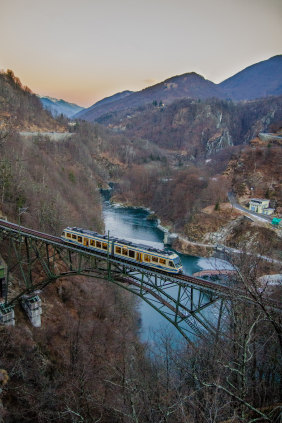
While Camedo Centovalli is scenic, it’s a regular railway serving local people as well as holidaymakers.
Then I head for Locarno in an unconventional way – by departing Switzerland altogether. A train takes me from Montreux over the border to Domodossola, Italy, where I can pick up a service along the Vigezzina-Centovalli line. Opened in 1923, this 52-kilometre narrow-gauge railway threads through mountainous farming country, then crosses into Switzerland before ending at Locarno.
Though scenic, it’s a regular railway serving local people as well as holidaymakers. I share a set of four facing seats with a smiling elderly local couple, and we all appreciate the passing show of lofty green hillsides rising above small settlements, with orchards and vineyards and appealing old-fashioned stations with wooden shutters.
Before long we’re back in Switzerland, though in the warmer southern canton of Ticino where I’m surprised to see palm trees in gardens. It’s been a relaxing two-hour run past mountains and ravines, with a dash of rural life thrown in.
Gotthard Panorama Express
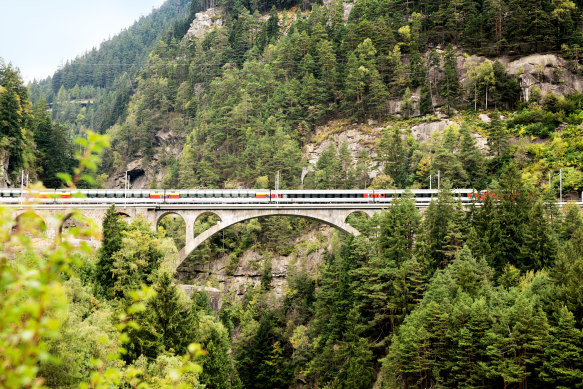
The Gotthard Panorama Express has a futuristic experience.
Here’s another riddle for you: when is a train not a train? That’s a trick performed by my next long-distance service, which transforms along its route.
First I take a local train to Bellinzona, to pick up the Gotthard Panorama Express after its departure from southern Lugano. I’m impressed by the train’s futuristic appearance: its carriages curve dramatically at the top to accommodate enormous windows. They give views onto mountains on both sides, as we approach the historic Gotthard Tunnel which runs for 15 kilometres beneath the Alps. The scenery grows ever more dramatic as the mountains tower above us.
Equally impressive is our on-train host Reinhard, who gives us facts and figures about our ride and hands out colourful prepaid postcards featuring the train, which we can send to anywhere in the world.
Then, through the tunnel, we passengers disembark at Fluelen, a town at the south-eastern end of Lake Lucerne. But the journey is not over – here the express turns into a boat as we transfer to Uri, a steamboat built in 1901. It’s a gorgeous confection of timber and chunky steam-driven engines, a neat contrast to the sleek modernity of the train.
Dining in the first-class section, I’m seated at a table on carpeted floors beneath a decoratively panelled ceiling. Lunch is simple and traditional: salad, beef patties, and vegetables including mashed potato. There’s chocolate cake for dessert, as we float onwards to Lucerne past the mountains and villages along the shores of the lake.
Voralpen Express
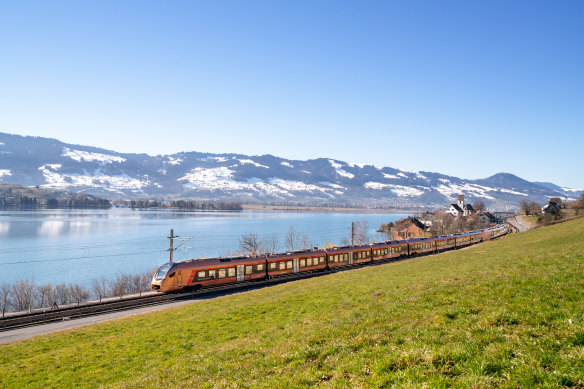
The Voralpen-Express passes pleasant scenery including long attractive lakes.
From Lucerne, I take a day-trip to Stans, for a jaunt to the summit of the Stanserhorn (1898 metres above sea level). First a charming 1893 funicular railway travels upward past views of meadows and mountains.
Then I transfer to the Cabrio, an up-to-date cableway in which passengers can sit outside the cable cars, via a staircase leading up to their roofs. If you want photos without window reflections, it’s an ideal solution. There is a panorama of lakes and mountains to see on the way up, and at the peak is a revolving restaurant serving cafeteria-style dishes (I recommend the schnitzel).
Back in Lucerne, I catch the Voralpen Express to eastern St Gallen. This is a regular service rather than an upmarket tourist train, passing pleasant scenery including long attractive lakes.

Cabrio cableway at the mountain station Stanserhorn.
St Gallen is the base for my final mountainous day-trip, via train and bus to Santis. This peak is not only the highest I’ve ascended on this trip, at 2502 metres above sea level, but it’s also a highly visible landmark and has views of six countries on a clear day: Switzerland, Germany, Austria, Liechtenstein, France and Italy. A cableway enables sweeping views on the way up to an impressive multi-storey structure. It’s modern, light and airy, with maximum access to the scenery via big windows and outdoor viewing areas.
Lunch at the restaurant here is very Swiss: white sausages with cheesy pasta and a beer on the side. And mountains all round.
The details
Fly & ride
Emirates flies to Zurich via Dubai, see emirates.com
The Swiss Travel Pass includes long-distance trains and local public transport. See rail.myswitzerland.com
Stay
Hotel Beausite is conveniently located in Interlaken, from CHF 118 ($207) a night. See beausite.ch
Mona in Montreux has great views of Lake Geneva, from CHF 171 ($300) a night. See mona-montreux.ch
Hotel Garni Muralto offers comfortable rooms in Locarno, from CHF 89 ($156) a night. See hotelmuralto.ch
The Lubo is a cutting-edge boutique hotel in Lucerne, from CHF 115 ($202) a night. See the-lubo.ch
Tailormade Hotel Leo is a stylish place to stay in St Gallen, from CHF 92 a night ($161) . See tailormade-hotels.com/leo/
The writer was a guest of Switzerland Tourism, see myswitzerland.com
Sign up for the Traveller Deals newsletter
Get exclusive travel deals delivered straight to your inbox. Sign up now.